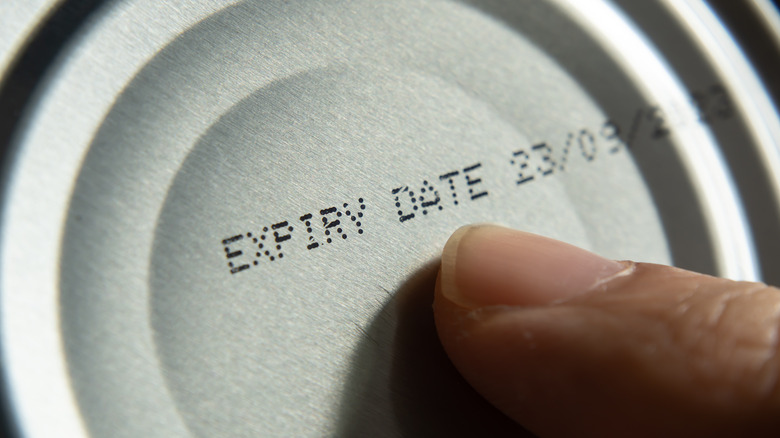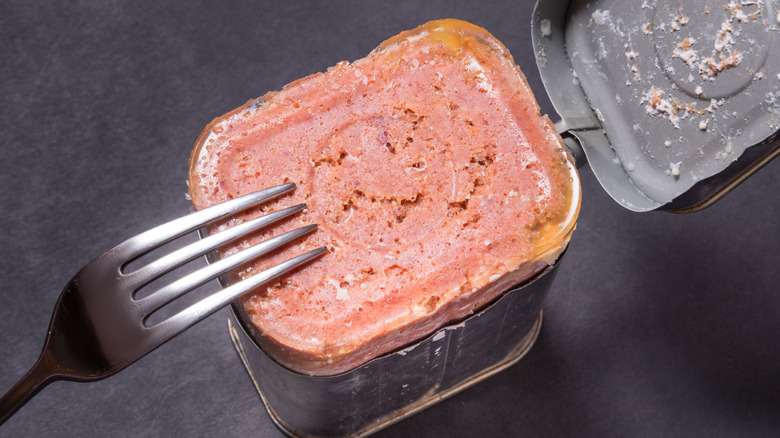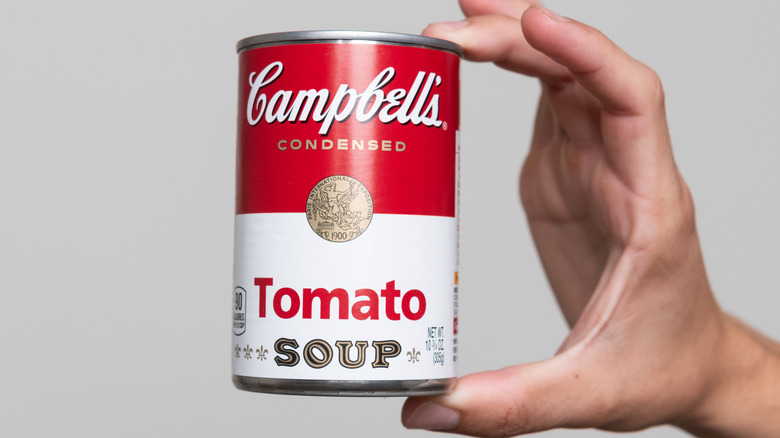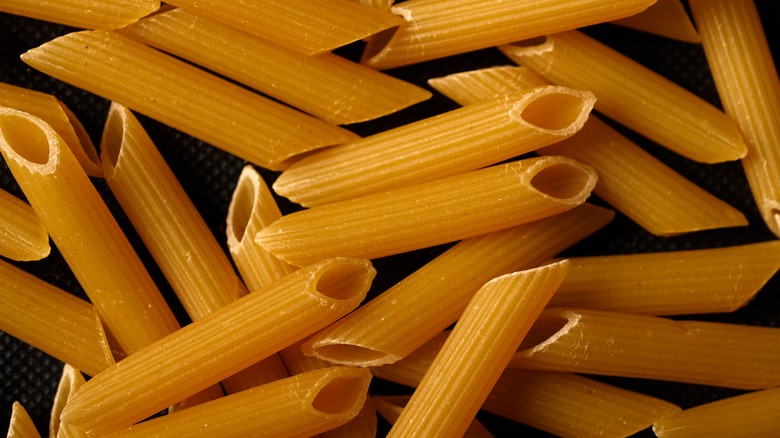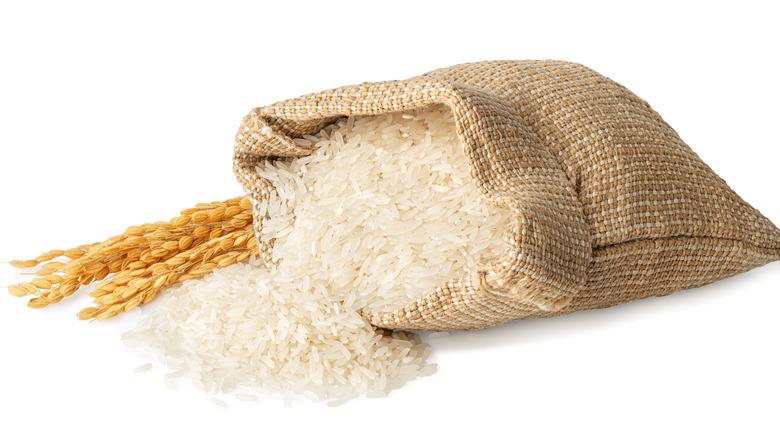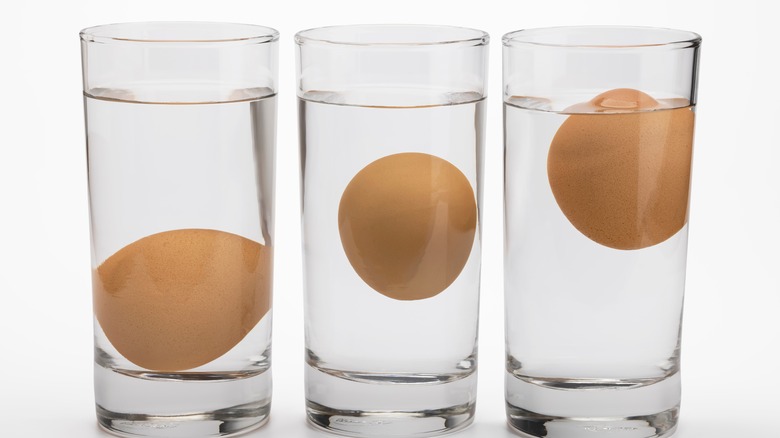What Really Happens When You Eat These Expired Foods
When you purchase food from a grocery store, you may notice a date printed, stamped, or written somewhere on the packaging. This date could mean a few things, but there is a good chance it is there to give you an indication of when the product you have bought will "expire." If your product has a "sell by" date — which, as the USDA explains, is something you tend to see on things like eggs — then that label isn't for you. It's actually there to let the store's employees know when that product has to be sold. Items past their sell by dates tend to be thrown away, though some expired items do get donated to food pantries. Then there are "best before" dates, which indicate when a food's texture and flavor will be of high quality. Products that have passed their best before days may still be edible but are unlikely to be as palatable as they were before the date passed. Finally, you have a "use by" date, which indicates the window within which a product will remain at "peak quality."
An important thing to note is that with the exception of baby formula, none of these dates are what the USDA describes as "safety dates." The dates are also not a legal requirement, at least federally, and are usually something a company puts on its products voluntarily. As far as the consequences that come with eating "expired" foods, it varies.
Expired canned meat
Rotten meat is something our bodies are built to avoid. The appearance and smell of a bad piece of meat are enough to turn most people's stomachs. It's natural to not want to take the risk with things like expired beef, chicken, pork, or lamb. However, according to The New Survivalist, properly canned meat may last far longer than you would expect. Although the date printed on the can may only be a year or two away from the date you purchased it, some types of canned meat can last up to 10 years if properly stored.
It isn't just the canning process itself that gives things like SPAM an incredible shelf life. The food's high salt content also does a lot to help preserve it. Other preservatives, such as nitrates, may also be present and extend the length of time the meat will be safe to eat. However, while salt and other preservatives will stretch out your canned meat's shelf life, sugar and acidic sauces will do the opposite. A can of corned beef may well last a decade, but a tin of beef ravioli in a sweet tomato sauce will go bad far faster. So if an older can is in good condition and contains some form of salted meat, eating it won't do you any harm. If the can is swollen, punctured, or rusted, however, you shouldn't take the risk.
Expired raw meat
While canned meat has a couple of preservation methods on its side, raw beef, chicken, and pork usually don't. If you buy a fresh steak from the grocery store and throw it in your fridge, there's no real chance of it being safe to eat a decade later. But though it doesn't have an extreme shelf life, fresh meat is a great way to illustrate how expiration dates are really just guidelines, and a guideline can be wrong both ways.
As Livestrong explains, improperly handled and stored fresh meat could actually be unsafe to eat before its expiration date has passed. If you buy a cut of meat with three days to go and leave it on the counter overnight during the summer, that food could be full of dangerous microorganisms regardless of what the date label says. Equally, if stored properly, there is a chance meat will be good after its expiry date has passed. Examining meat for signs of decay and giving it the old sniff test has helped humans avoid foodborne illnesses for centuries. Freezing can also help keep food safe long after its expiry date has passed. The USDA has extensive guidelines for freezing and claims raw meat is actually a better candidate for freezing than its cooked counterpart. Looking at the packaging can also provide some helpful instructions, with many manufacturers recommending food is frozen before it passes its expiry date.
Expired canned soup
As with all canned foods, the condition of the can itself is more important than an expiry date. Extensive rust, holes, or swelling could indicate harmful bacteria have made their way into the can. Eating anything bad can be highly dangerous and even fatal in some cases. Assuming the can is in good condition, there are other factors to consider when eating things like expired canned soup. The main thing to be aware of is the soup's acidity levels and what effects that can have on the can. Acidic soups, like tomato, can react with their containers, and the soup's quality can be impacted as a result. If you want to eat an acidic soup at its best, you may have less than two years to do so. If you choose to eat expired tomato soup, and the can seems to be okay on the outside, you probably won't feel any ill effects. However, the U.S. Food Safety and Inspection Service says the food's texture, flavor, and nutritional value could all be affected due to its reaction with the can. Manufacturers are aware that their product may interact with its packaging, so a lot of cans are lined with plastic or ceramics to minimize that interaction and extend shelf life.
With really old canned soup, there is something else to consider. Cans manufactured before 1991 may be very hazardous for your health. That's because lead was one of the materials used to manufacture the can, and that heavy metal will have had a long time to potentially leach into any food stored within it. So while there's a slight chance soup in a 30-year-old can may not be spoiled, it really isn't worth the risk.
Expired bread
Bread has been a dietary staple for centuries. The term also covers a wide variety of products, most of which vary in quality, characteristics, and shelf life. Bread will go bad in several ways depending on the conditions it is stored in. If mold develops, the bread should be discarded and not eaten. While a lot of molds are harmless, some can have damaging toxins, and ingesting them is not worth the risk. If mold is spotted on one slice, that doesn't make another safe to eat — the whole loaf should be thrown away. According to Healthline, eating moldy bread can lead to stomach problems and cause damage to your gut biome, increasing your chances of developing an illness.
If the bread smells, looks, and feels fine you can probably eat it without any ill effects. Bread can also dry out and go "stale." Eating stale bread isn't necessarily bad, and if the only issue is some dryness, you can ingest the bread without any ill effects. Stale bread tends to make better toast — a few minutes under the broiler could turn an unpleasant slice into a crunchy treat. Preservative-stacked loaves of Wonder Bread will stay in their store-bought conditions far longer than the artisan stuff, as even mold has standards.
Expired pasta
Pasta is one of those foods with a notoriously long shelf life, so one would assume you can ignore the sell-by date without too many problems. But believe it or not, the dried noodles can in fact go bad. As with most other things, storage conditions are more important than anything printed on the packaging and pasta should be kept in a cool, dry place if you want it to remain edible for as long as possible. While heat and moisture can cause it to go off, properly stored pasta is one of those foods that can remain safe to eat indefinitely. How the pasta looks might give more indication of its quality than any date the manufacturer has slapped on there — with "off" pasta crumbling or appearing dry and brittle, per Foreign Fork.
Even if it looks a bit crumbly, eating pasta long past its expiry date is unlikely to do you any harm. Without any moisture, microbes can't grow and the chances of foodborne illness are minimal, per Bustle. However, the quality of a pasta's taste and texture might decline with age. If your pasta did get damp at one point, it could develop mold. As with the fungus that grows on old bread, ingesting moldy pasta can lead to health problems, per the Cleveland Clinic. So if it looks, smells, or tastes off, do not take the risk.
Expired fish
According to the USDA, any fish that isn't frozen will only last a few days with proper storage. The fish that does make it into the freezer will be edible indefinitely, regardless of the expiry date, but may not have a desirable texture or flavor by the time it makes it onto your plate. The longer the fish is frozen, the greater the risk of flavor and texture loss. The USDA recommends frozen cooked fish be eaten within three months, and raw fish in under eight months, if you want a palatable meal.
Fish can spoil if left at room temperature for as little as two hours. Rotten fish, along with other off seafood, can be a breeding ground for dangerous bacteria, according to Aquafind. If you really must ingest a putrid former sea creature, there are a few dishes around the world that involve fish left to rot in controlled environments. Iceland has a national dish that is essentially shark that has been buried and left to ferment. The shark is a bit of an acquired taste and is usually chased with a shot of schnapps. Similarly, Sweden has an infamous delicacy called Surströmming, which is basically rotten haddock in brine.
Expired rice
Rice is one of the world's most popular foods, and you'd be forgiven for thinking it can be stored indefinitely. It usually comes as a bag of dried grains, but unlike other dried foods such as pasta, your rice can have some very unpleasant things living on it. In terms of average shelf life, white rice is usually good for two years whereas brown rice is at its best for a far shorter timeframe. Healthline estimates that the brown rice you have stored could be past its best after around six months.
Signs of spoilage can include the presence of insects, strange coloring, an oily texture, or the presence of mold. As with many grains, mold is a danger when eating a product that has been in storage for a while. However, rice can also be dangerous when cooked. It can contain a bacteria called bacillus cereus, which is not destroyed by the cooking process. The toxins produced by these bacteria can cause food poisoning if ingested.
Expired canned vegetables
The shelf life of canned vegetables will vary depending on the characteristics of the vegetable itself. On average, most canned vegetables can be eaten a couple of years past their sell by date with no ill effects (via Eat By Date). The heat and salt applied during the canning process tend to stretch out the life of most canned vegetables, though some nutritional value is lost along the way. As with other canned goods, the actual lifespan will depend on the exact vegetable that has been canned and what it has been canned with.
Peas canned in water will last longer than artichoke hearts in a tomato sauce as the acidic sauce will react with the can. The canning process sterilizes the can's contents, so as long as the container isn't heavily rusted, punctured, or damaged, the food within won't spoil. While you won't get food poisoning as long as the can is in good condition, the further canned vegetables go past the printed sell by date, the greater the loss of nutritional value. Flavor, texture, and the vegetable's appearance can also be impacted.
Expired chocolate
If you've ever found an old chocolate bar, you may notice a white substance appears to have grown over its surface. This substance is something called "bloom," per HuffPost, and it shouldn't really worry you. Although it can look similar to mold, it isn't dangerous at all and does not indicate a chocolate bar is inedible. How long a bar of chocolate will remain good to eat depends on a few factors.
The first is the type of chocolate you're storing. Dark chocolate lasts longer than any other kind, up to two years if refrigerated. Milk chocolate stays fresh on average around half the time dark chocolate does. White chocolate has an even shorter shelf life than milk chocolate, though it probably shouldn't even count as it doesn't actually contain any chocolate. The other factor is if the chocolate bar's packaging has been opened. Despite what the expiry date says, dark chocolate should remain fresh for at least two years from the date of manufacture, with milk and white chocolate being good for at least a year. Eating chocolate that is a while past its sell by date could also have some benefits. The High Five Company says that some in the chocolate world believe the confection can develop new complex flavors as it ages — a bit like wine does. So if you bite into an older bar, there's a chance you'll find it more palatable than a new one.
Cheese
Cheese is essentially an expired product to begin with. Several varieties, including Roquefort and Stilton, are purposely laced with a desirable species of mold. That mold gives the cheeses their characteristic appearance and contributes greatly to their final flavors. Other cheeses are aged under certain conditions for months or even years. During the aging process, the cheese's flavors get more intense and crystals sometimes develop which add an interesting crunchy texture. But all of this takes place in a carefully controlled environment. So what do you do if the cheese in your fridge exceeds its sell by date?
The chances are you can eat it without any ill effects. It may have simply matured further and will taste more intense as a result. If the cheese in question is medium or hard, any mold that has developed can be cut around and discarded. If soft cheese gets moldy, however, the fungus has probably penetrated deep within the cheese and it should be thrown out. Cheese is only really bad if it develops an ammonia-like smell or makes your mouth tingle or burn a little when you nibble it. Basically, if it tastes or smells awful, you probably shouldn't eat it. Eating expired cheese that looks or smells like that could easily lead to foodborne illness.
Preserves
According to Can It Go Bad, preserves like jam can remain perfectly edible years past their sell by date if stored within a sealed container. Perfectly edible doesn't mean as good as new though, and older jams can lose a lot of the sweet, fruity flavors that make you want to eat them in the first place. Open jars are a different story and require closer inspection. If mold is visible or any odd smells are present, eating the jam is probably not worth the risk. Depending on what is contaminating your jam, there is also a small chance of alcohol developing within your preserve. If the correct strain of yeast makes its way in there and starts eating the sugar, you will probably get a touch of booze in your fruity spread. However, it probably isn't great to drink and should again be discarded.
While a sealed jar stays good for years, an open jar will probably develop mold or some other major issue within a year. The peak time to eat it — or, in other words, when the flavors are at their most pleasant — also reduces when the jar is opened. If you've popped the lid, your jam will start to lose its flavor after a month or two.
Jell-O
Jell-O is made from gelatin, and what happens when it's past its best depends on the kind of Jell-O you're using. Pre-prepared Jell-O will break down a little and develop a watery layer, whereas powdered Jell-O will remain pretty much as it was when you bought it for a long time. The pre-prepared stuff should last at least a week past its sell by on the shelf and can be perfectly fine more than a month after its expiry date if you've kept it in the fridge, per Eat By Date. Once it starts to separate and that watery layer begins to build up, pre-prepared Jell-O becomes an attractive target for mold. If you spot any undesirable growths, you shouldn't risk eating it.
With powdered Jell-O, storage is important as any moisture will ruin it. If the powdered stuff has been kept in a cool dry place, it should be safe to eat indefinitely. You may notice slight changes in color and flavor after a while, and any extreme changes in either should be an indicator that it's time to toss your powdered Jell-O (via Does It Go Bad?).
Expired eggs
While eating some expired products may just leave you with an off flavor in your mouth, eating expired eggs can have some pretty dire consequences. Eggs have been known to harbor a pathogen called salmonella, which really doesn't get along with the human digestive system. Symptoms of salmonella infection include vomiting, stomach cramps, diarrhea, and fever, so the bacteria is best avoided (via the CDC). Fortunately, with modern food safety practices, an egg has a three-to-five-week fridge life before it has a good chance of making you sick, according to the USDA.
There are a few ways to tell that your eggs are off. The most notable is its smell — a rotten egg has a distinct sulfurous smell and won't taste much better. Other indicators your egg is far from fresh are a powdery shell, red and/or white spots on the yolk, excessive runniness of the whites, discoloration of the yolk, and, in the case of a pseudomonas bacteria infection, a pink yolk. If an egg is only recently expired you should be able to eat it with no problems. There is also a simple test to help check if an egg is fresh enough to eat. Put the egg in a glass or bowl of water. If it floats, throw it away. If it sinks to the bottom, the egg is edible.
